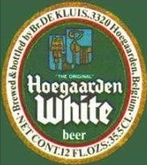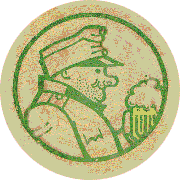During fermentation so-called white beers develop a pale head of foam, and, since they're often unfiltered, suspended sediment can give these concoctions a milky mien. And like many traditional beers, white beers pursue a secondary fermentation in the bottle that can also make them hazy with yeast.
While some of these beverages take their appelations from wheat – German Weizen; tarwe in Flemish; froment in French – others, like the one we're going to consider today, are named for their cloudy, pale-yellow-verging-on-white color: Weisse, wit, blanche. They might more accurately be called gelbes Biers, but who wants to drink something called yellow beer.
Anyway, to press on with today's lesson, beers made using wheat are usually fermented with ale yeasts, making them lighter than those employing lager cultures. Since white beers aren't usually very high octane, they make great hot weather refreshments, perfect for the deck of your yacht. Only a shade more mundanely, they also make a great companion for fruity desserts, like Library Alehouse's superb Mocha Torte with Raspberry Sauce. Back home in Belgium, they're typically served in chunky, bevelled tumblers that look like French pastis. Very classy.
A long time ago in a galaxy far away, in the days before barley came to dominate brewing, wheat beers were produced all over the place. In Germany and Belgium, wheat beers never entirely went away, and they've made a big comeback with the growing market for "light" beer. The traditional use of fruits, spices and herbs as seasoning began to recede as hops gained the upper hand in the middle of last millennium. In Germany, only hops are now permitted, though a barkeep or patron has been known to add fruit, raspberry syrup or essence of woodruff, whatever that is,* to some styles of beer.
The best-known Belgian Witbier or Bière Blanche is the principal justification for the existence of Hoegaarden, a pretty but otherwise insignificant town in the wheat-growing Brabant farmlands east of Brussels and Leuven.
 In the 1960s, a local milkman named Pieter Celis, about whom more in a moment, revived a traditional brewing style of the region that ordinarily combined equal portions of raw wheat and malted barley (sometimes with an admixture of oats), spiced it up with dried Curaçao orange peels and ground coriander seeds and -- something else…what? cumin, maybe -- and then fermented the lot with a conventional yeast.
In the 1960s, a local milkman named Pieter Celis, about whom more in a moment, revived a traditional brewing style of the region that ordinarily combined equal portions of raw wheat and malted barley (sometimes with an admixture of oats), spiced it up with dried Curaçao orange peels and ground coriander seeds and -- something else…what? cumin, maybe -- and then fermented the lot with a conventional yeast.The resulting drink, named Hoegaarden after its hometown, is a lovely and enticing elixir, pouring a very pale yellow color that intensifies to a hazy gold when the yeast sediment is aroused. If held up to the light, the liquid appears almost off-white, true to its witbier ycleption. The creamy head sustains with a moussy feel.
As far as taste goes, there's enough complexity here to incite the verbal excesses of a wine connoisseur: a sugary wheat flavor
 dominates, but the coriander and citrus, often pursued by a mild phenolic aroma, contribute to a complex, elegant, nearly winy disposition. Heady, virtually Bazooka-level sweetness, bestowed by the cereal grass, frequently with plum, apple or banana appoggiaturas, is nicely undercut by the piquant orange and herb colorations – you'll think you're catching intimations of cinnamon, cloves, pepper and nutmeg -- and by a faintly astringent dryness. That trailing nose is bright and highly fruity, with a pleasing hint of muskiness. Behind it all, a muted and nectarious bitterness, reminiscent of the absent hops, is probably contributed by the amaroidal orange peel.
dominates, but the coriander and citrus, often pursued by a mild phenolic aroma, contribute to a complex, elegant, nearly winy disposition. Heady, virtually Bazooka-level sweetness, bestowed by the cereal grass, frequently with plum, apple or banana appoggiaturas, is nicely undercut by the piquant orange and herb colorations – you'll think you're catching intimations of cinnamon, cloves, pepper and nutmeg -- and by a faintly astringent dryness. That trailing nose is bright and highly fruity, with a pleasing hint of muskiness. Behind it all, a muted and nectarious bitterness, reminiscent of the absent hops, is probably contributed by the amaroidal orange peel.Despite its lightness and freshness, this is a beverage that weighs on the tongue, graceful, bracing, yes, but because of the wheaty twang and slight acidity, surprisingly firm and grainy, with more heft than you'll ever encounter in German Weizen beers.
If it were a movie actress, Hoegaarden would be Anne Heche.
Lastly, an aside: Pieter Celis, who had reincarnated Belgian white beer, sold Hoegaarden but was subsequently unhappy with the bier as produced by its new owners (he was a purist, after all). Entrepreneurial Pieter (now Peter) relocated to Austin where he microbrewed a similar drink, Celis White (the real Hoegaarden, I guess) that was very popular in Texas in the 90s. A familiar story followed: In 1995, Miller Brewing bought majority interest in Celis' brewery, took complete control early in 2000, by December 2000 announced the brewery would be closed and sold, and ceased production before the beginning of 2001 (apparently, neither Starbucks nor Walmart was involved). At the time, the equipment and brands were sold to Michigan Brewing Co., but it now appears Celis White is under license by the De Smedt in Opwijk, a two-hundred-years-old family-run brewery north-west of Brussels that makes Abbey beers (Affligem, Aulne and Postel).
As this saga demonstrates, beer ain't just beer.
_________________________________________________________________________
*Looked it up, of course:
wood·ruff
 P Pronunciation Key (w
P Pronunciation Key (wn.
- A fragrant perennial herb (Galium odoratum) native to Eurasia and North Africa and widely cultivated as a shade ground cover, having small white flowers and narrow leaves used for flavoring wine and in sachets. Also called sweet woodruff.
- Any of various plants of the genus Asperula, having whorled leaves and small funnel-shaped flowers.






No comments:
Post a Comment